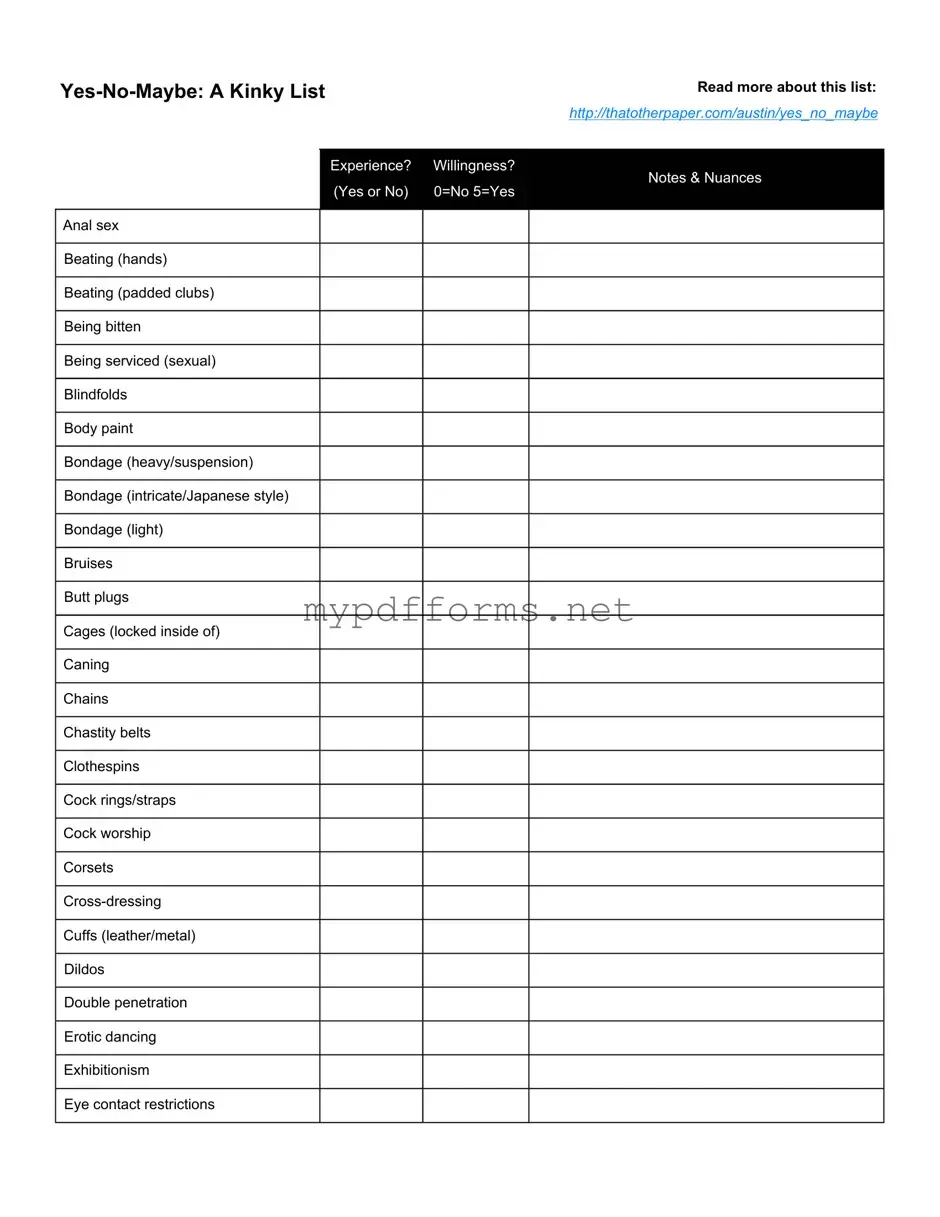The Yes No Maybe List form is similar to a consent checklist used in various relationship dynamics, particularly in BDSM contexts. These checklists help individuals communicate their boundaries and preferences clearly. They often contain a list of activities, allowing participants to indicate their comfort level with each. This fosters open dialogue and ensures that all parties understand each other's limits and desires, creating a safer and more consensual experience.
Another document that shares similarities is the Risk Awareness Consent Checklist. This document is often used in workshops or events focused on BDSM practices. It outlines potential risks associated with specific activities, helping participants make informed decisions. By addressing safety concerns upfront, this checklist promotes responsible practices and encourages participants to engage in discussions about consent and risk management.
The Kink Negotiation Form is also akin to the Yes No Maybe List. It is typically used during discussions about engaging in kink activities. This form allows individuals to negotiate specific terms, such as safe words, limits, and aftercare preferences. By using this document, participants can ensure that everyone is on the same page before engaging in any activities, thus enhancing trust and understanding.
Consent Forms are another related document. These forms serve as a legal acknowledgment of consent to engage in specific activities. While they may be more formal, they share the same goal of ensuring that all parties are aware of and agree to the terms of their interaction. Consent forms can provide a sense of security, especially in situations where the activities may involve higher risks.
The BDSM Contract is a more comprehensive document that outlines the terms of a relationship or scene. It often includes details about roles, limits, and expectations. Like the Yes No Maybe List, it serves to clarify consent and boundaries, but it may also delve deeper into the dynamics of the relationship. This helps participants understand their responsibilities and commitments to each other.
Another similar document is the Scene Agreement. This is often used for specific events or encounters and details the activities that will take place. It may include safety protocols, safe words, and aftercare plans. By having a written agreement, all parties can refer back to it, ensuring that everyone remembers the established boundaries and desires.
For those navigating the complexities of motorcycle ownership, understanding the necessary documentation is essential. The California Motorcycle Bill of Sale is a valuable resource that ensures clarity in transactions and protects the rights of all parties involved. This important form, which you can find at motorcyclebillofsale.com/free-california-motorcycle-bill-of-sale, helps facilitate a smooth transfer of ownership and provides peace of mind regarding the sale.
The Personal Safety Plan is also relevant. This document outlines strategies for maintaining safety during BDSM activities. It may include emergency contacts, safe words, and exit strategies. While it focuses on safety rather than preferences, it complements the Yes No Maybe List by ensuring that all participants are prepared for any situation that may arise.
Another related document is the Aftercare Plan. Aftercare is crucial in BDSM practices, as it addresses the emotional and physical needs of participants following a scene. This plan outlines how individuals will support each other post-activity, ensuring that everyone feels safe and cared for. It complements the Yes No Maybe List by emphasizing the importance of ongoing communication and care.
The Play Negotiation Sheet is also similar. This document is often used just before engaging in a scene to finalize details. It may include a checklist of activities, boundaries, and preferences, similar to the Yes No Maybe List. This sheet helps to confirm mutual understanding and consent right before the experience, reinforcing the importance of clear communication.
Lastly, the Communication Agreement serves to establish how participants will communicate their needs and boundaries throughout their relationship. This document emphasizes the ongoing nature of consent and encourages regular check-ins. It aligns with the Yes No Maybe List by promoting a culture of open dialogue and continuous consent, ensuring that everyone feels comfortable expressing their desires and limits.
